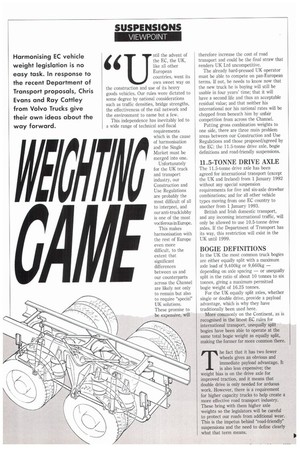SUSPENSIONS
Page 20

If you've noticed an error in this article please click here to report it so we can fix it.
VIEWPOINT
ntil the advent of the EC, the UK, like all other European countries, went its own sweet way on the construction and use of its heavy goods vehicles. Our rules were dictated to some degree by national considerations such as traffic densities, bridge strengths, the effectiveness of the rail network and the environment to name but a few.
This independence has inevitably led to a wide range of technical and fiscal
it
requirements which in the cause of harmonisation and the Single Market must be merged into one.
Unfortunately for the UK truck and transport industry, our Construction and Use Regulations are probably the most difficult of all to interpret, and our anti-truck lobby is one of the most vociferous in Europe.
This makes harmonisation with the rest of Europe even more difficult, to the extent that significant differences between us and our counterparts across the Channel are likely not only to remain but also to require "special" UK solutions. These promise to be expensive, will therefore increase the cost of road transport and could be the final straw that renders UK Ltd uncompetitive.
The already hard-pressed UK operator must be able to compete on pan-European terms. If not, he needs to know now that the new truck he is buying will still be usable in four years' time; that it will have a second life and thus an acceptable residual value; and that neither his international nor his national rates will be chopped from beneath him by unfair competition from across the Channel.
Putting gross combination weights to one side, there are three main problem areas between our Construction and Use Regulations and those proposed/agreed by the EC: the 11.5-tonne drive axle, bogie definitions and road-friendly suspensions.
The 11.5-tonne drive axle has been agreed for international transport (except the UK and Ireland) from 1 January 1992 without any special suspension requirements for five and six-axle drawbar combinations; and for all other vehicle types moving from one EC country to another from 1 January 1993.
British and Irish domestic transport, and any incoming international traffic, will only be allowed to use 10.5-tonne drive axles. If the Department of Transport has its way, this restriction will exist in the UK until 1999.
In the UK the most common truck bogies are either equally split with a maximum axle load of 9,400kg or 9,660kg — depending on axle spacing — or unequally split in the ratio of about 10 tonnes to six tonnes, giving a maximum permitted bogie weight of 16.25 tonnes.
For the UK equally split axles, whether single or double drive, provide a payload advantage, which is why they have traditionally been used here.
More commonly on the Continent, as is recognised in the latest EC rules for international transport, unequally split bogies have been able to operate at the same total bogie weight as equally split, making the former far more common there.
The fact that it has two fewer wheels gives an obvious and immediate payload advantage. It is also less expensive; the weight bias is on the drive axle for improved traction, and it means that double drive is only needed for arduous work. However, there is a requirement for higher capacity trucks to help create a more effective road transport industry. These bring with them higher axle weights so the legislators will be careful to protect our roads from additional wear. This is the impetus behind "road-friendly" suspensions and the need to define clearly what that term means.




























































































